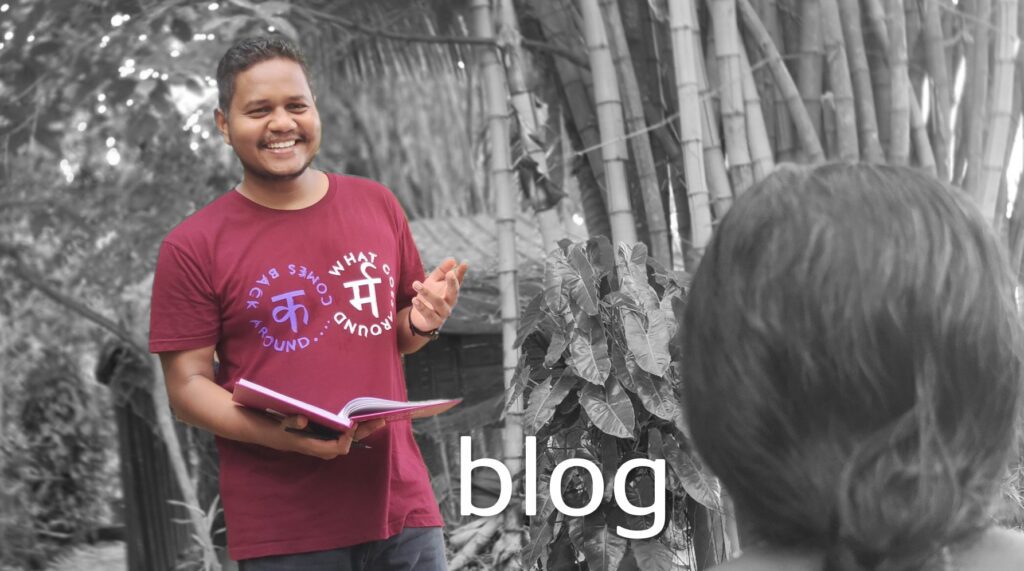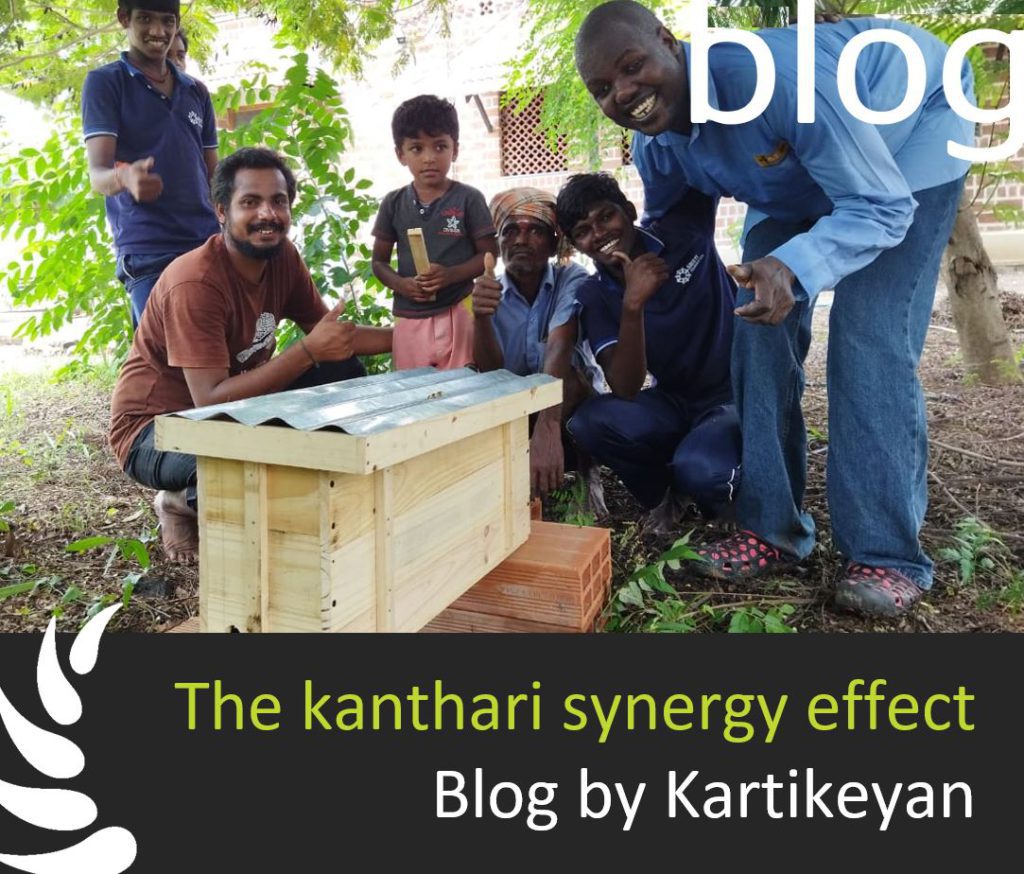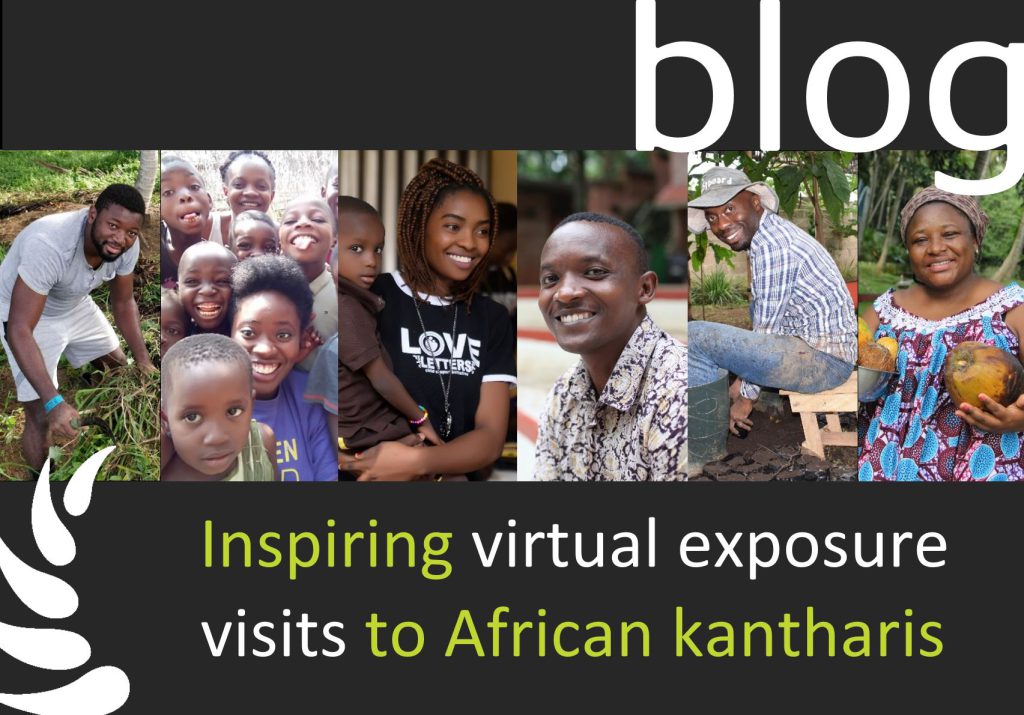Heritage and Struggles of a Tribal Life
Tudu belongs to the Santhal tribe, one of the largest tribal communities in India. It is a tribe with its own language, cultural heritage, and religion. In school, he faced discrimination from students of other castes. In his own village, he observed serious problems such as alcoholism, poverty, and superstitious beliefs. Despite—or better, because of—the gap between his own culture and the “regular” Indian society, he managed to complete his bachelor’s and master’s degrees in Anthropology and Tribal Studies. This motivated him to work for the upliftment and empowerment of his community by wanting to start a tribal school that opens opportunities to both worlds.
by Prashant Tudu,
The Village of Lakra Kol: Where Tradition Meets Nature
Lakra Kol is a village nestled on the bank of the Ghumani River, with a lush green forest covering Rajmal Hill on the other side. This village, belonging to the Santhal tribe in Jharkhand, has vast agricultural lands and is home to about 16–17 households, including mine. All these households rely on agriculture for their income. Like most children, I used to help my father prepare the soil in the fields before the sowing season. Every morning, I would take the cows to graze in the green fields. During the monsoon season, I loved fishing in small ponds using mosquito nets and bamboo baskets. In the afternoons, my friends and I would have fun climbing mango and jackfruit trees.
School Days: A Struggle for Basic Education
We all attended a local government school, walking through muddy roads and fields. There were about 200 to 300 tribal students and only 4 or 5 teachers. I went to school regularly for the mid-day meal provided there, and we would sit on the floor as there were no benches in the classrooms. During the harvest season, none of us went to school as we helped our parents with the crops. We had a lot of fun in school. I remember playing football with my friends, making balls from scrap fabric. Our teachers were very supportive. Before exams, they would tell us the questions and instruct us exactly what to write so that we could all pass.
High School: Facing Discrimination and Prejudice
Despite being an average student, I made it to high school, which was far from my village, where students from different communities studied together.
High school was not fun. I was discriminated against by the seniors, especially those from upper castes like Kurmi, Yadav, and Bhumihar. They would make me clean their rooms and run errands during my study time. I felt humiliated when a senior told me not to touch them. If I didn’t understand something in class and asked questions, the teacher would shout, “How many times do I need to tell you…?”
Battling Stereotypes and Finding Purpose
When I scored low marks, teachers would tell me to quit studying and work on the farms or in the mines instead. They even used abusive words against my tribe, such as ‘Sala Sotar,’ a derogatory term used by members of the upper castes to describe us tribals. It means that we are thieves of their resources. All this affected my studies, and I failed the 12th standard twice.
Breaking Through Barriers with Education
With constant encouragement from my parents, I passed high school and joined college for a bachelor’s degree in Anthropology and Tribal Studies. I was one of the few people from my village to earn a degree. During my studies and field visits, I came across many problems faced by tribal communities across India, such as lack of health facilities, poor infrastructure, tribal land grabbing, illicit alcohol brewing, superstitious beliefs, and more.
From my village, the nearest primary health center is more than 20 km away, and thus many get treatment from a Jhola chap (unqualified medical practitioner).
Alcoholism: A Deep-rooted Crisis in Tribal Life

Alcohol is a part of every tribal group. In my tribe, ‘Hadia’ (rice beer) is very popular, especially during the Sohrai and Baha festivals*.
Most men in my community are addicted to Hadia. They don’t go to work. I lost four family members due to excessive alcohol consumption. They started drinking at a young age. Once, I witnessed a horrific incident in my village. Two people killed a widow, accusing her of being a witch and practicing black magic. They prayed at our tribal worship place and boasted about killing the “witch.” We caught the perpetrators and handed them over to the police. That was when I promised myself to help my community overcome these problems that have held us back for so long. But the question is, where to start?
The Power of Education: A Dream to Transform Lives
I concluded that everything starts with education. And our education is based on our identity, our culture, and our myths. Let me take you on a quick journey through our genesis: The Santhal tribe believes that the earth is carried on the back of a tortoise. When the tortoise moves, the earth shakes. We worship nature, and our gods live among us in the forms of trees, stones, or animals. We have many beautiful sagas, but there is no space for this in regular schools. Tribal children grow up feeling that their culture is irrelevant. They live in two contradictory worlds and don’t belong to either.
A Vision for the Future: Checht Kuwak Aatu – The Learner’s Village
Therefore, my dream is to start “Checht Kuwak Aatu – The Learner’s Village.”
Here, we prepare preschool children for their journey through education. I call these young learners “Janum Bili,” after the small fruit that tastes so sweet.
The Learner’s Village consists of “Oraks,” small huts made from mud and bamboo. Since Santhal children have to live in various cultures, each Orak represents a different world. There is the Orak of the Santhal world, where our “Jamun Billis” only speak in Santali. Here, they learn how to read and write in the Olchiki script. Another Orak represents the Hindi world, and yet another the Foreign world, each with its languages and cultures, which they learn through theatre and games.
A Growing Dream: Expanding the Learner’s Village
In the future, I envision opening the Learner’s Village to older children, ages six to nine. I call them “Badidari Dari,” after a strong tree that grows in our forests and has medicinal leaves. They will learn all subjects in a very practical way. Mathematics will be taught through building huts and calculating height and space. Biology will be learned through forest walks and gardening.
A Bridge Between Two Worlds
Many children from my tribe drop out of school because non-tribal teachers fail to spark their curiosity. The subjects taught in a regular curriculum are little or not at all related to Santali tribal culture. Thus, I believe we need a bridge to help children gain confidence in their roots and feel comfortable learning new ideas. With a strong foundation in their own Santali world, they will be able to open up to the Hindi and foreign worlds. They will become mind travellers while always knowing where they belong.
(* Sohrai and Baha are two major festivals in the Santhal tribe. We celebrate Sohrai after the harvest. It takes place in January, when we invite relatives, share food, and drink alcohol. We eat non-vegetarian dishes with new-harvest rice, and we worship our ancestors for their blessings. In Baha, we pray to Jaher Era, the goddess of the sacred grove. The Jaher is a worship place outside the village, surrounded by teak trees. We celebrate Baha in March.)
Save the dates: kanthari TALKS 2024 are scheduled for Friday 13-12-2024 and Saturday 14-12-2024
And you can not only hear Prashant Tudu’s inspiring stories, but 22 more! Check out www.kantharitalks.org to learn more.
Thank you for sharing and spreading the word.



